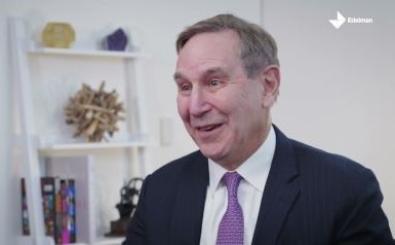Thought leadership is one of those phrases that has been muddled by over use. When it comes to public affairs and thought leadership, it becomes even more confused.
It sometimes refers to public intellectuals who help establish entire cultural debates, people like Wangari Maathai or Thomas Piketty.
Sometimes it refers to individuals working for an organisation whose expertise in their field is unmatched - the expert spokespeople who, according to our Edelman Trust Barometer data, are once again dominating the public's trust.
But at other times it's about a brand taking ownership of a particular niche topic within its sector. This applies to NGOs, Businesses, Public Sector organisations and Media companies alike.
Ultimately, what we're talking about when we say 'thought leadership' is building a reputation for understanding the future in a way others (such as competitors) cannot. For any public affairs practitioners reading, the jump to using that reputation to influence the policymaker agenda should be obvious.
For the second year running, LinkedIn and Edelman joined forces to produce a study looking at the Impact of B2B Thought Leadership[1]. The results were stark:
- More than 90% of people making buying decisions say that it’s “important” or even “mission critical” for an organisation to produce thought leadership material.
- Around half of these decision makers told us that they spend at least one hour a week reading thought leadership material.
- Nearly two-thirds use it to vet organisations for their vision and original thinking before even considering to work with them.
I give this advice to clients every week: thought leadership isn't optional anymore. It's how you frame your identity in a chaotic information landscape - if you don't do it, you're just living campaign to campaign.
How to make it work for public affairs teams
Public Affairs teams can use this information to supercharge their outreach - particularly online.
We know that it can be hard work to make policy oriented content shine in the digital media landscape, leaning into truly thought provoking material is a great way to fix that.
So many organizations around Brussels spend a lot of time and money producing high-level research. Hiring smart researchers and organizing panel studies, conducting massive online surveys or working out econometric modelling are serious commitments.
Don't let that work go to waste.
"Sending out basic facts and figures on Twitter or sharing your latest white paper as a PDF simply won't cut it anymore".
First of all, understand how the thought leadership you've produced ladders back into your overall brand. Edelman's Trust Barometer, for example, underpins our internal values and forms the baseline of the advice we give to clients.
Thought leadership outputs should build your brand. And if it does, it makes it easier to sell to key stakeholders.
Imagine if Delmonte, for example, launched a thought leadership platform based on the impacts of AI on democracy. You wouldn't take it seriously, and neither would the policymakers they wanted to influence.
We use a fairly rigorous model to map out and understand a brand in all its complexity – both for clients and for ourselves.
It starts with the guiding mantra of your brand, which is just one simple phrase, and ends to a detailed narrative that describes where you came from, what you stand for and where you're going.
Many branding exercises fail to land internally because they aren't anchored in a set of agreed values that your colleagues recognize or believe in. It doesn't matter how much time you spend on brand work if employees won't champion it.
Externally, however, branding falls flat when the way it's presented - the look and feel - doesn't chime with the story that brand is presenting.
If a company is looking to define itself as an activist brand that stands for something but all its outreach material is written in drab, lawyer-approved language, the whole exercise falls flat. Even worse, if all their competitors are also trying to look like activist brands, the audience immediately sees this 'new' attempt at branding as hollow.
This is the kind of thing you'll need to have worked out and internalized to properly plan a thought leadership platform.
(If you need this kind of brand work please reach out to us!)

Once you have that defined, you can spin your thought leadership content into a stream of content across every channel you have - or that your target audiences use.
This fits very nicely to a common online marketing strategy - the pillar content model.
Pillar content in the world of public affairs has always tended to be long form and written - a white paper or a report. That can still work, especially if you build in an excellent executive summary that the top level policymakers might be expected to read, but it isn't the only option.
The internet has made communication much more visual, with video being the clear format of choice for online audiences. The time people spend watching online video has grown exponentially - in 2018 people averaged a staggering 6 hours 45 minutes a week on Facebook and YouTube videos alone[2].
45% of online audiences watching more than an hour of video per day[3]. Taking your report and re-imagining it as an educational video might be the thing that takes your reputation beyond the ranks of your existing followers and allies.
Hyper polished videos can be intimidating and expensive to produce. There are other options for pillar content that can be done more easily: record a keynote speech and release it as a podcast; turn your key powerpoint deck into an animation or downloadable e-book; or present your key policy points as filmed interview. Pillar content is anything substantial that audiences can set aside some time to dig into and that your communications team can mine for further content.
Clips and highlights, killer stats as graphics, quote graphics - these are all ways to make pillar content live on. Give audiences a taste through your social channels and then drive them back to the pillar content for more information.
Don't let your channels hold you hostage
Social media channels should be used to distribute and disseminate micro-content. Think of them as teasers, trailers or classic hooks to bring your audience to the main event.
Compared to other markets, Brussels is a relatively reluctant adopter of social media. There are two main blockers that I hear: one, the fear of backlash. Two, the fear of escalating production and management costs with very little ROI. There is a lot to be said about both concerns but, as the first is a deeper issue that deserves its own blog post, I'll focus on the second.
Perhaps my most repeated piece of advice for clients: don't be afraid to re-use content in your social channels.
Tweets only exist on people's feeds for about 18 minutes[4]; even if your target audience is on Twitter in that short window, most people are going to scroll right past it
There is a reason you see online ads chase you around the internet over and over - repetition works. Most people miss or ignore your perfectly crafted message the first time anyway. As a guide, use the cadence below to push content and then test what works best for your audience (more on testing in the second half of this article).

I've been running social accounts for organizations all around the world for over a decade and have never had a single person complain about repetition.
Once you understand this, the prospect of filling up your social media calendar becomes a lot less daunting.
As for the fear of backlash - unless you have a very large audience or deeply committed enemies the reality is that most people aren't paying attention.
For 99% of organizations, the real problem is earning attention in the first place.
Taking this offline
Whenever you're planning an event that ties into your thought leadership platform, it's important to think beyond the event itself.
Events are, of course, a great place to showcase or even film pillar content but it doesn't need to stop there.
Is your CEO giving a keynote on the topic next month? Tease it with a soundbite you release on social media. Trying to figure out how to get journalist to pay attention? Repackage that keynote as an op-ed and pitch it.
Reputation is partly build by ubiquity.
If I see a video about your report on Facebook, then somebody Tweeting a graphic about it, see the name referenced in an article and then hear about it at an event I'm far more likely to remember your messages.
I'm also far more likely to remember your organization.
Thought leadership platforms are built over multiple platforms, online and offline, delivered via owned and earned media over a period of months and years.
A trusted reputation doesn't come easy. That's why it's worth so much.








